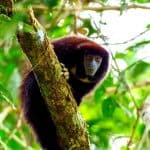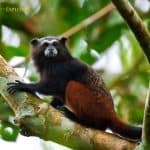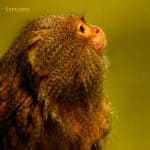small mammals - search results
If you're not happy with the results, please do another search
Milton’s Titi
Milton's titi (Plecturocebus miltoni) also called the fire-tailed titi monkey, is a species of titi, a type of New World monkey from the Amazon rainforest of southern Brazil.
Miller’s Saki
Miller's Saki (Pithecia milleri), also called Miller's monk saki, is a species of the saki family, a type of New World monkey. Miller's sakis are diurnal and quadrupedal leapers. They usually move on all fours but can be seen swinging bipedally on large branches before leaping to another tree.
Martins’ Tamarin
Martin's tamarin (Saguinus martinsi) or Martin's ochraceous bare-faced tamarin, is native to Brazil. These tamarins are distinguished from other New World monkeys by their small size and modified claws instead of nails on all digits except the big toe.
Río Cesar White-fronted Capuchin
The Río Cesar white-fronted capuchin (Cebus cesarae) is a gracile capuchin monkey native to the Cesar River Valley in northern Colombia. Like other monkeys of the genus Cebus, the Río Cesar white-fronted capuchin is named after the order of the Friar Capuchins because the crests of these friars closely resemble the coloring of the monkey's head.
Rio Beni Titi
The Rio Beni tití is a New World monkey species belonging to the genus Callicebus of the family Pitheciidae. It is native to Bolivia and is found mainly in the eastern parts of Bolivia in the upper basins of the Mamoré and Grande rivers.
Rio Acari Marmoset
The Rio Acari marmoset (Mico acariensis) is endemic to Brazil. It was first described in the year 2000. These Brazilian monkeys use their specialized claws to forcefully grip tree trunks and gnaw small holes in the bark with their lower incisors and canines.
Red-handed Howler
The red-handed howler monkey (Alouatta belzebul) is an endangered species of howler monkey, a New World species. Red-handed howler monkeys are diurnal, although they spend most of the day (up to 80%) sleeping on tree branches with members of their squad.
White-tailed Titi
White-tailed titi monkeys, also called red titi monkeys or red-crowned titis and not to be confused with coppery titi (Callicebus cupreus), also commonly known as red titi, are endemic to the dense rainforest and gallery forests of Peru and Ecuador.
Red-Chested Mustached Tamarin
The Red-chested mustached tamarin (Saguinus labiatus), also known as Red-bellied Tamarin, is a tamarin that lives in the Amazon region of Brazil, Peru, and Bolivia. The red belly of these New World monkeys is their most striking external feature.
Silvery Brown Bare-face Tamarin
The white-footed tamarin (Saguinus leucopus), the silvery-brown bare-faced tamarin, is native to Colombia. It is silvery brown with pale stripes and reddish underparts. It closely resembles the cotton-tipped tamarin from which it is separated by the Atrato River.
Satéré Marmoset
The Satéré marmoset (Mico saterei) is native to Brazil and its genus is characterized by claw-like nails rather than the flat nails of other primates, long lower incisors, a specialized caecum, and squirrel-like movements in trees.
Santarem Marmoset
The Santarem marmoset (Mico humeralifer), also called the black-and-white tassel marmoset, is a marmoset native to the Amazon and Pará states of Brazil. Santarem marmosets make long cries with their rapidly vibrating tongue, designed to sound like a cricket, and shorter chirps.
Santa Marta White-fronted Capuchin
The Santa Marta white-fronted capuchin (Cebus malitiosus) is a species of gracile capuchin monkey native to Colombia. The Santa Marta white-fronted capuchin range is restricted to forests near northern Colombia's northwestern base of the Sierra de Santa Marta.
Rondon’s Marmoset
Rondon's Marmoset (Mico rondoni), also called the Rondônia marmoset, is a small species of monkey in the Callitrichidae family found in the southwestern Amazon of Brazil. Rondon's marmoset was only described in 2010, and its name refers to the famous Amazon explorer Cândido Rondon.
Lucifer Titi
Lucifer Titi (Cheracebus lucifer) is a species of Titi, a New World monkey endemic to South America. It is found in Peru, Ecuador, Colombia, and Brazil. This yellow-handed Titi was described as Callicebus lucifer in 1914.
White-eared Titi
The white-eared Titi, Plecturocebus donacophilus, also known as the Bolivian gray Titi or Bolivian Titi, is a marmoset species, a New World monkey endemic to eastern Bolivia and a region of western Brazil.
White-cheeked Spider Monkey
The white-cheeked spider monkey (Ateles marginatus), also known as the white-whiskered spider monkey, is a New World monkey native to the Amazon Basin of central Brazil.
Weeping Capuchin
The Weeping capuchin, also known as the chestnut capuchin and chestnut weeper capuchin (Cebus castaneus), is a capuchin monkey endemic to northeastern Brazil, southern Guyana, French Guiana, and Suriname. This primate is also known as Wedge-capped capuchin.
Weddell’s Saddle-Back Tamarin
The Weddell's saddle-back tamarin (Leontocebus weddelli) is a species of saddle-back tamarin, a species of small South American monkey. Weddell's saddle-back tamarins are tree dwellers. As such, they are phenomenal climbers with sharp claws that allow them to cling to the sides of trees.
Variegated Spider Monkey
The Variegated spider monkey or brown spider monkey (Ateles hybridus) is an endangered species of spider monkey, a species of New World monkey endemic to the forests of northwestern Venezuela and northern Colombia.
Vanzolini’s Bald-faced Saki
Vanzolini's Bald-Faced Saki (Pithecia vanzolinii) is a species of saki monkey, a species of New World monkey. Vanzolini's bald-faced saki monkey was first cataloged by naturalist Alfonso Ollala in 1936. His account describes a monkey with a long, fluffy tail and golden fur on its limbs.
Urubamba Brown Titi
The Urubamba brown titi (Plecturocebus urubambensis) is a species of Titi, a New World monkey native to Peru. This species is found east of the Tambo River and west of the Urubamba, Manú, and Madre de Dios rivers.
Toppin’s Titi
Toppin's Titi (Plecturocebus toppini) is a species of Titi, a species of New World monkey endemic to Bolivia, Peru, and Brazil. It got its name from Captain Toppin, who collected the type specimen of this species near the Tahuamanu River in Peru.
Spix’s Red-handed Howler
Spix's Red-Handed Howler (Alouatta discolor) is a species of howler monkey endemic to the southeastern Amazon in Brazil. Spix's Red-headed Howler is currently on the International Union for Conservation of Nature's Endangered Species List based on a population decline of more than 30% over the last 3 generations, mainly due to habitat loss.
Parecis Titi
The Parecis titi (Plecturocebus parecis) is a species of titi, a New World monkey native to Brazil. The range of the new species is in the deforestation arc of the Amazon, where large tracts of forest are being destroyed for timber, settlements, and industrial agriculture.
Ornate Titi
The ornate titi (Plecturocebus ornatus) is a species of titi and the smallest member of the Pitheciidae family, including the uakari and saki monkeys. Ornate titis have a monogamous mating system. A couple has a strong bond and stays together for years.
Ollala Brothers’ Titi
The Ollala Brothers' titi (Plecturocebus olallae) is a marmoset species of New World monkeys native to Bolivia. Like all Neotropical primates (except Aotus), the Ollala brothers' titi monkeys are highly diurnal.
Maranhão Red-Handed Howler
The Maranhão red-handed howler (Alouatta ululata) is native to forests (e.g., Babaçu forests) in the northeastern Brazilian states of Piauí, Maranhão, and Ceará. Red-handed howler monkeys are among the least studied species of all howler monkeys.
Madidi Titi
The Madidi titi also called the Golden Palace monkey, is a titi, a New World species of monkey discovered in 2004 in Madidi National Park in western Bolivia. The species got its name, Golden Palace, from an online casino after an auction.
Lesson’s Saddle-Back Tamarin
Lesson's Saddle-Back Tamarin (Leontocebus fuscus) is a small New-world monkey endemic to South America. Its type locality is in Colombia, on the plains of Mocoa, Putumayo, between the Caquetá River and the Putumayo River.
Lake Baptista Titi
The Lake Baptista titi, Plecturocebus baptista, is a species of titi, a New World monkey native to Brazil. Lake Baptista Titi was initially described as Callicebus baptista in 1939.
Kaapori Capuchin
The Kaapori capuchin (Cebus kaapori) also known as Ka'apor Capuchin, is a capuchin monkey native to Brazil. Previously considered a subspecies of the wedge-capped capuchin monkey (Cebus olivaceus), it was elevated to species status recently.
Red-headed Titi
The red-headed titi (Cheracebus regulus) (also known as Juruá Collared Titi) is a marmoset species of New World monkey endemic to Brazil. Red-headed titi monkeys are diurnal and arboreal, waking up and sleeping with the sun.
Isabel’s Saki
Isabel's Saki (Pithecia isabela) is a New World monkey species, native to a small part of northern Peru. The species was named in honor of Isabel Godin des Odonais, an 18th-century Ecuadorian noblewoman who traveled across South America to find her husband.
Illiger’s Saddle-Back Tamarin
(Leontocebus illigeri) is a species of saddleback tamarin, a type of small monkey native to South America. Illiger's saddleback tamarin is native to the Peruvian Amazon, and its type locality is in Loreto, Peru, on the left bank of the lower Ucayali River.
Hoffmann’s Titi
Hoffmann's Titi (Plecturocebus hoffmannsi) is a New World primate native to Brazil. It was described as Callicebus hoffmannsi in 1908. These primates have small to medium-sized bodies. Hoffmann's titis are known to live in small, pair-bonded, and territorial groups and are considered monogamous by most biologists.
Hershkovitz’s Marmoset
The Hershkovitz marmoset (Mico intermedia), also called the Aripuanã marmoset, is endemic to the Amazon rainforest of south-central Brazil. The common name references Philip Hershkovitz, an American zoologist.
Hairy Saki
The hairy saki (Pithecia hirsuta) is a species of saki monkey, a New World primate species. The species was identified by Johann Baptist von Spix in 1823 but later merged with the Mönk saki (P. monachus). Then, a 2014 study revived it as a separate species due to differences in fur coloration.
Red-backed Bearded Saki
The red-backed bearded saki (Chiropotes chiropotes), also known as Guianan Bearded Saki, is a New World monkey native to South America. They live in groups of about 40 members of both sexes, sometimes separated into groups when traveling or foraging, their primary occupation.
White Marmoset
The white marmoset (Mico leucippe), also called the golden-white bare-eared marmoset, is an endangered marmoset native to the Amazon rainforest of Pará, Brazil.
Golden-mantled Tamarin
The golden-mantled tamarin (Leontocebus tripartius) is native to South America. The golden-mantled tamarin is an arboreal, diurnal species that leaps and walks quadrupedally through the undergrowth.
Golden-faced Saki
The golden-faced saki (Pithecia chrysocephala) is a New World monkey found on the northern side of the Amazon on both sides of the Rio Negro in Brazil. This species was previously classified as a subspecies of white-faced saki (Pithecia pithecia) but was upgraded to full species status in 2014.
Golden Angwantibo
The golden angwantibo is a strepsirrhine primate of the Lorisidae family. Bärenmaki, meaning "lemur bear," is the German name for the golden angwantibo due to its bear-like appearance. However, we see no resemblance.
Geoffroy’s Saddleback Tamarin
Geoffroy's Saddleback Tamarin is a saddled tamarin, a species of small monkey native to South America. Geoffroy's saddleback tamarins often associate and form mixed groups with mustached tamarins (Saguinus mystax). Both species often perch in the same tree, responding to each other's alarm calls.
Equatorial Saki
The Equatorial Saki, also known as the red-bearded Saki, is a species of saki monkey and New World monkey. They are most common in riparian, seasonally flooded, and swampy forests but have also been seen in terra firme forests.
Emilia’s Marmoset
The Emilia's marmoset also called the Snethlage's marmoset, is a marmoset native to Brazil. The species is named after Emilie Snethlage, a German-born Brazilian ornithologist.
Ecuadorian Squirrel Monkey
The Ecuadorian squirrel monkey is a species of the squirrel monkey. Although it occasionally ventures to the ground to play or feed, the Ecuadorian squirrel monkey is strictly an arboreal primate.
Eastern Pygmy Marmoset
The eastern pygmy marmoset is a species of marmoset, a tiny New World monkey found in the southwestern Amazon rainforest. Notably, at just over 100 grams (3.5 ounces), the eastern pygmy marmoset is the smallest monkey and among the smallest primates in the world.
Eastern Black-handed Tamarin
The Eastern black-handed marmoset (Saguinus ursulus) is a species of marmoset native to Brazil. These tamarins are mainly covered in jet-black fur, with only a small area around the nose and eyes and most hairless ears.
Cruz Lima’s Saddleback Tamarin
The Cruz Lima saddleback tamarin is a species of saddleback tamarin, a small monkey native to South America. The Cruz Lima saddleback tamarins were formerly thought to be a subspecies of the brown-mantled tamarin (Leontocebus fuscicollis).
Collins’ Squirrel Monkey
Collins' Squirrel Monkey is a species of squirrel monkey endemic to Brazil. Until a genetic study by Jessica Lynch Alfaro et al. raised them to the species category, Collins' squirrel monkey had been considered a subspecies of the squirrel monkey (Saimiri sciureus).
Collared Titi
The collared titi, also called the widow monkey, or yellow-handed monkey inhabits the lush rainforests of the Amazon and is typically found south of Río Negro and north of Río Solimões. Titi monkeys are often known to "duet" with each other, either between an adult female and an adult male, an adult female and her son, or an adult male and his daughter.
Coimbra Filho’s Titi
or Coimbra titi is a species of titi, a New World primate native to the forests of the Brazilian states of Sergipe and Bahia. It is named in honor of Adelmar F. Coimbra-Filho, founder and former director of the Rio de Janeiro Primate Center, for his Brazilian biology and primatology work.
Chacoan Titi Monkey
The Chacoan Titi Monkey is a species of titi (also called White-coated Titi), a type of New World monkey native to South America. These diurnal monkeys are stealthy and hard to spot as they navigate the canopy. They move between branches and trees by walking or jumping on four limbs.
Cazuza’s Saki
Cazuza's Saki is native to northwestern Brazil. Populations of this species were previously classified as Rio Tapajós saki (Pithecia irrorata). Still, a 2014 study found that these populations had a pelage distinct from all other species in the genus and were therefore considered their own species, Pithecia cazuzai.
Caquetá Titi
The caquetá titi also called the bushy-bearded titi or red-bearded titi, is a species of titi monkey native to Colombia in the Caquetá region. Dr. Marta Bueno, Thomas Defler, and their student Javier García of the National University of Colombia are credited with the 2008 discovery of the Caquetá-Titi monkey.
Burnished Saki
The Burnished saki is a species of saki monkey, a species of New World monkey. It is located in central Peru and a small part of adjacent Brazil. The species was described by Johann Baptist von Spix in 1823 but was later merged with the monk saki (Pythecia monachus).
Buffy-tufted Marmoset
The buffy-tufted marmoset, also called the white-eared marmoset or buffy-tufted-ear marmoset is a New World monkey living in the forests of the Atlantic coast of southeastern Brazil. Unlike most marmoset monkeys, buffy-tufted-ear marmosets are mainly insectivorous, although their diet is generally carnivorous.
Buffy-headed Marmoset
The buffy-headed marmoset is a rare species of marmoset native to the tropical rainforests of southeastern Brazil. These miniature and shy monkeys are mostly tree dwellers, crawling on 4 legs (quadrupeds) from tree to tree with jerky, squirrel-like movements.
White-footed Saki
The white-footed Saki, also called the white Saki or buff saki, is a species of saki monkey, a New World species native to western Brazil. They hang from branches and hold on with their hind legs while eating seeds and fruits.












































































